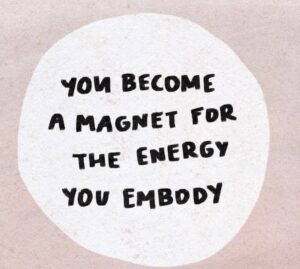
WE ARE MAGNETS FOR THE ENERGY WE EMBODY
 With the discovery of mirror neurons in the early 1990’s, many scientists came to realize that we understand others not by thinking, but by feeling their experience. That is, mirror neurons let us not only “simulate” others’ actions. They also let us reflect the intentions and emotions behind those actions. For example, when we see someone smile our mirror neurons for smiling become activated in response, too, creating a sensation in our own mind of the feelings we associate with smiling.
With the discovery of mirror neurons in the early 1990’s, many scientists came to realize that we understand others not by thinking, but by feeling their experience. That is, mirror neurons let us not only “simulate” others’ actions. They also let us reflect the intentions and emotions behind those actions. For example, when we see someone smile our mirror neurons for smiling become activated in response, too, creating a sensation in our own mind of the feelings we associate with smiling.
When I became aware of this concept early on in my conflict management coaching practice, I also became more mindful about how I show up and the ways I might impact the many interactions I engage in with family, friends, coaching clients and so on. I observed more how others influenced me with their perceived moods, bodily and facial language, tone of voice and so on. I paid more attention to what I had sensed for a long time- a tendency to interpret and read into others’ ways of interacting. I found too that my interpretations were not always accurate, and this is when assumptions creeped into the picture. Luckily, this discovery and awareness resulted in me becoming more careful to check out what I am experiencing, to ask more questions and not rely on my own lens to interpret what I am observing and sensing.
This week’s Conflict Mastery Quest(ions) blog considers how we experience one another when in conflict and how we can set ourselves up for the conflict dynamic in ways that have an impact on the interrelationship – positively and negatively. Since we embody and convey energy it is a matter of holding up a mirror and reflecting what we attract and how we can be a magnet for good means and for not-so-good ones, too.
When responding to this set of questions, I suggest that you consider a situation in which you encountered negative emotions coming from someone with whom you are in dispute or it’s evident one is brewing:
- What is the situation?
- What is it you are sensing from the other person?
- From what specifically are you picking up those things (your answer to the above question) such as their tone of voice, body and facial language etc.?
- What is the impact on you?
- What do you suppose you are assuming about the other person including their intent?
- What might you be conveying to the other person through your facial language? Through your words and tone? Through your body language?
- In what ways are you conveying those messages (your answer to the previous question)?
- What sorts of negative interpretations might the other person be making about you based on what they are picking up?
- What might the other person do or say to shift the dynamic to a more positive one through their words, tone of voice, body and/or facial language?
- In what ways may you choose to influence the dynamic more positively through your words, tone of voice, body and/or facial language?
- What else occurs to you as you consider these questions?
- What insights do you have now that you didn’t have before you answered these questions?

